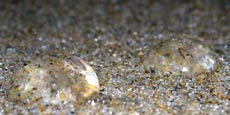 |
Published 05/12/09
Tiny Wonders Lurk in Sands of Oregon Coast Beaches
 (Oregon
Coast) - A closer look at Oregon's beaches often reveals new things, but
it can create more questions than it answers. It certainly proves there's
much more to the geology and biology of the Oregon coast than meets the
eye.
(Oregon
Coast) - A closer look at Oregon's beaches often reveals new things, but
it can create more questions than it answers. It certainly proves there's
much more to the geology and biology of the Oregon coast than meets the
eye.
On one spring day a couple years ago, an up close peek at the sands at Hug Point - near Cannon Beach - showed some tiny wonders appearing on the beach. Seaside Aquarium’s Tiffany Boothe found a miniscule creature called the gooseberry, also known as comb jellies. Their scientific name is Pleurobrachia, and Boothe says they periodically show up on the Oregon coast when west winds push them onshore.
“They are both residents of near shore and open ocean habitats,” Boothe said. “They are abundant at times along the West Coast, but as with all jellies they are not seasonal. They can wash up anytime. They can swim, but not against the ocean's currents. So like the purple sails, which wash up periodically in great abundance, causing a massive fishy smell, they are at the mercy of the ocean. Strong west winds will strand them on the beach.”
 |
| A gooseberry (Pleurobrachia) - photo Seaside Aquarium |
Gooseberries are barely a quarter inch in diameter, and look like big bubbles sitting by the tide line.
They are actually completed unrelated to jellyfish, although these translucent, spherical creatures are often mistaken for them. Gooseberries come with two feathery tentacles, which can be retracted into special pouches. The name comb jelly refers to the eight rows of hair-like cilia on their bodies, which vibrate and enables them to swim.
Boothe says they also differ from regular jellies because they have no stinging cells (called nematocysts). “They capture their food with a transparent mucous 'net,' ‘ Boothe said. “They are strictly carnivores, feeding on a variety of platonic animals. They are both residents of near shore and open ocean habitats.”
Even more striking about them: at night, they are bioluminescent, meaning they glow.
 |
| A close-up of sand reveals a startling array of colors |
Boothe’s close-up shots of these creatures are stunning enough. But the unusual nature of the sand around them begs further questioning. Why so many colors in the sand here, since the beach itself at Hug Point appears to be no different in color than most beaches? Is this normal? Do all beaches have this many kinds of grain all over?
The answers were startling. Newport’s Guy DiTorrice (fossil expert known as Oregon Fossil Guy and Oregon Coast Beach Connection columnist), said every beach has its own different composition.
“The sand is ‘colored’ by the predominate minerals present in the rock formations in its immediate area and from any creek or river outflow,” DiTorrice said. “The central and north coasts tend to be browner/tan, thanks to all the Astoria formation sandstone that's around. On the southern Coast - Curry County - the sand has a very dark and gray coloring to it, as the many exposures of Nye and Coledo formation rock are very ash laden.
 |
| Gooseberries photo Tiffany Boothe, Seaside Aquarium |
“Now add to this base formula the crushed and tumbling remains of basalt, all sorts of quartz/agates, minerals (e.g. gold, garnets, etc), fossilized (usually silicated or agatized) bone, shells and woods. Then mix in the additional impact of near-coastal outflows (treated/untreated human and Mother Nature's). Finally, add the additional contributions of oil (crude and processed), broken up aluminum cans, plastic water bottles and colored glass from a variety of sources, and you get some pretty spectacular colors.”
DiTorrice said sand is very dynamic, containing various kinds of rock, like boulders, cobble, pebble and concretion made from all sorts of materials, such as quartz, mica and granite. “You can see that each beach produces its own unique type and colors of sand. And, as is the case of so many things in our universe, there are people who collect sands to illustrate just how different it can be around the world.”
For more about Oregon Coast Lodging....
 |
 |
 |
RELATED STORIES
Unusual Travel Articles TravelParanormal.com allows you to submit your own creepy tale or debunk one - or see up-to-the-minute news headlines about travel and the paranormal.
Watching Transformations of Oregon Coast Beaches Seasons change and so do beaches, revealing different sides and a variety of eye-popping sights
Staggeringly Cool Ideas for Oregon Coast Romance Be it the season of Valentine's or be it any time of the year, Oregon's coastline has essentially cornered the market for cuddle-inducing possibilities and gushy activities for the hand-holding set
Day or Night Mysteries and Merriment on Oregon Coast It's more than just nightlife that comes to life, but the beaches offer major opportunities
News Headlines from All Over Oregon Need to scan Oregon headlines? Constantly updated news from all over Oregon: a comprehensive, up-to-the-minute display of news headlines from a variety of media.
Oregon
Coast Lodging
|
||||||||||||||
|
Secrets of the Season |





































